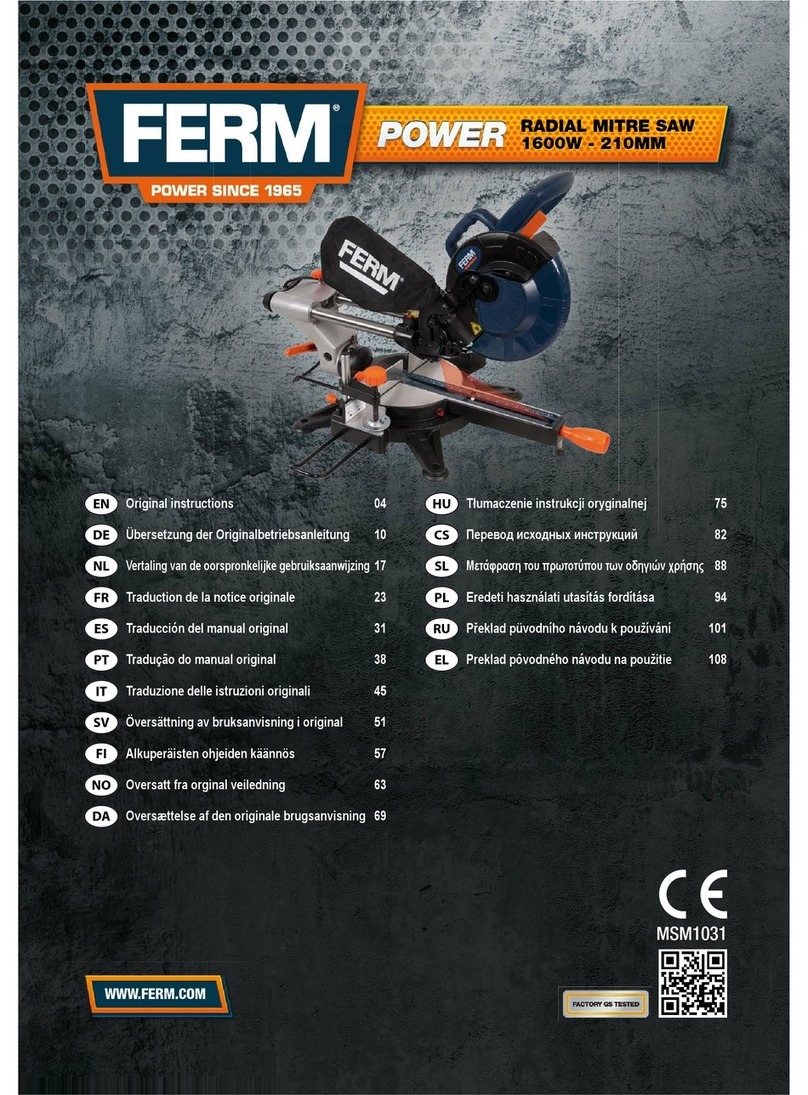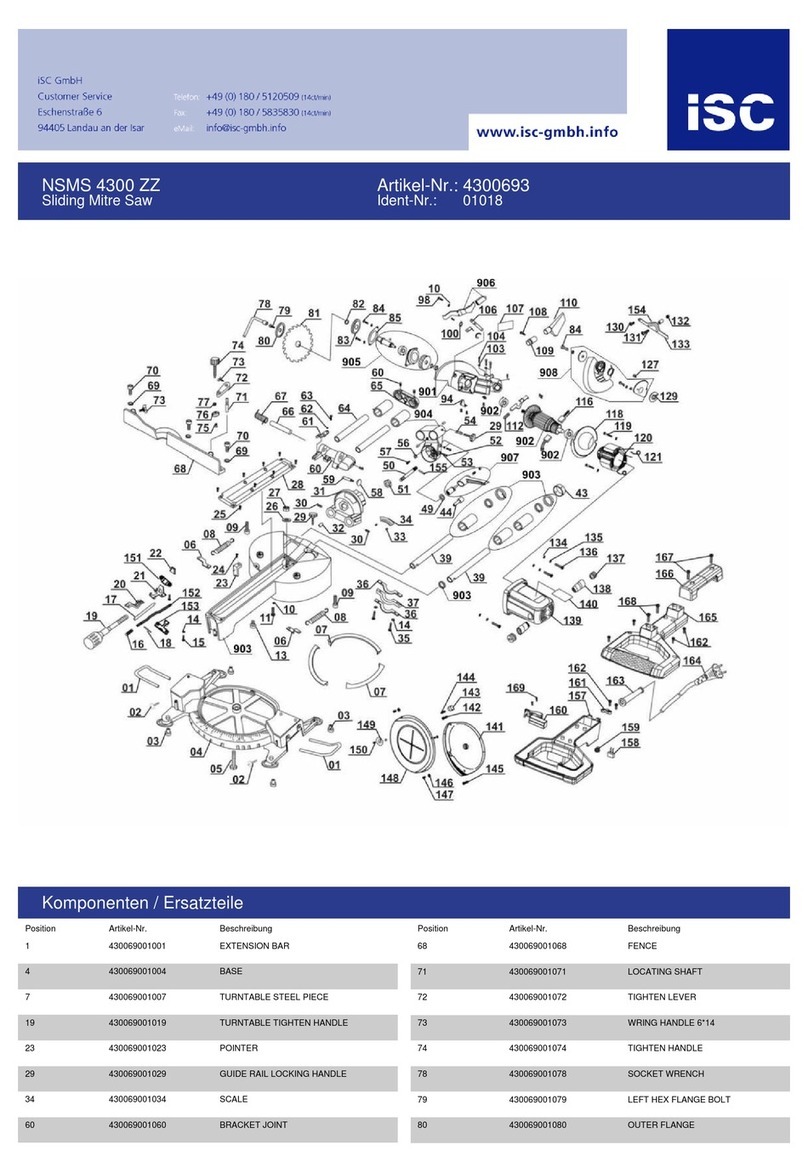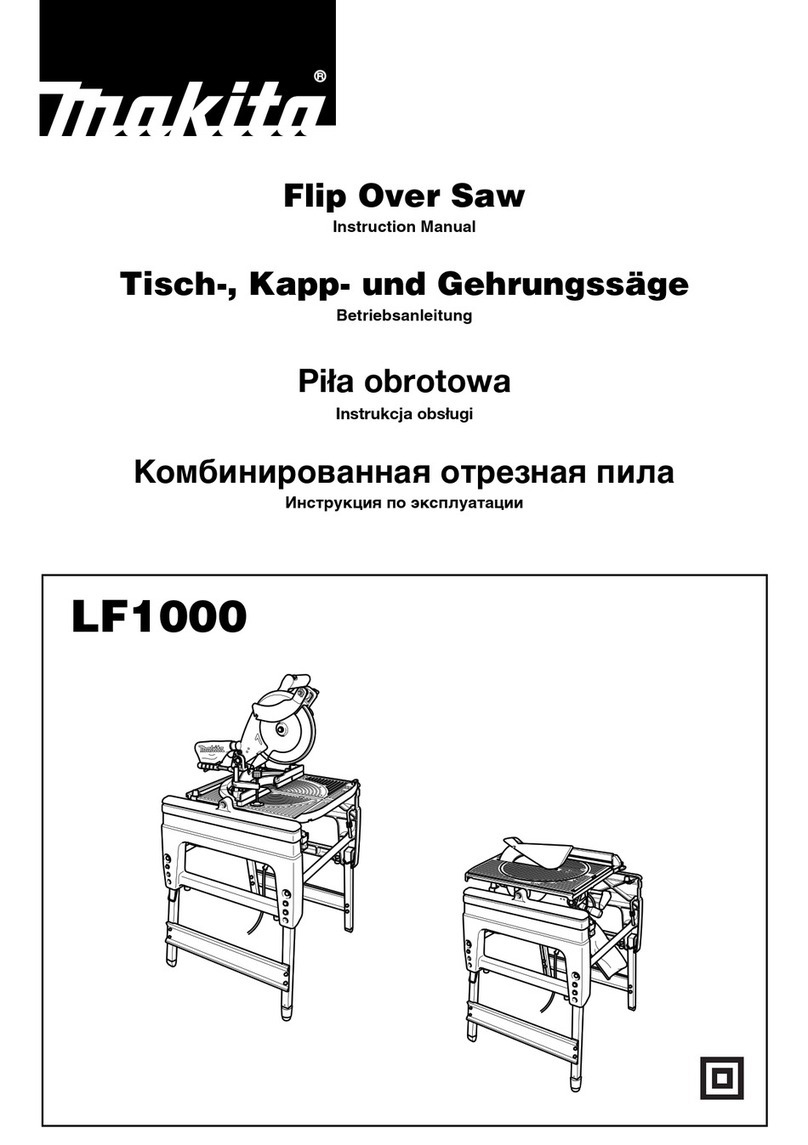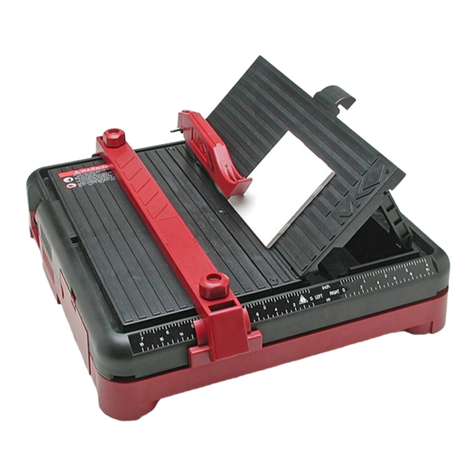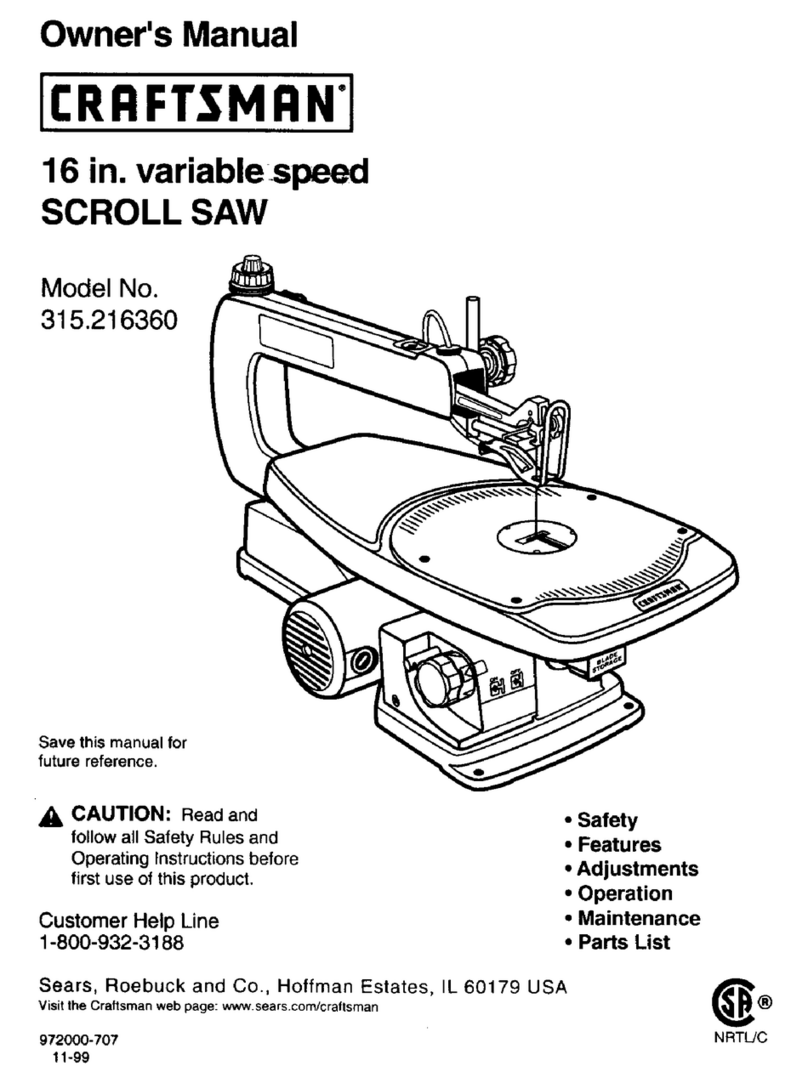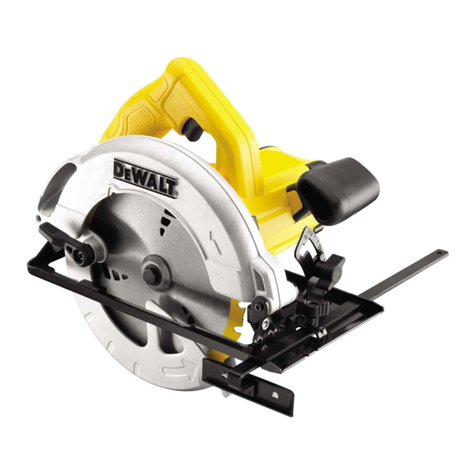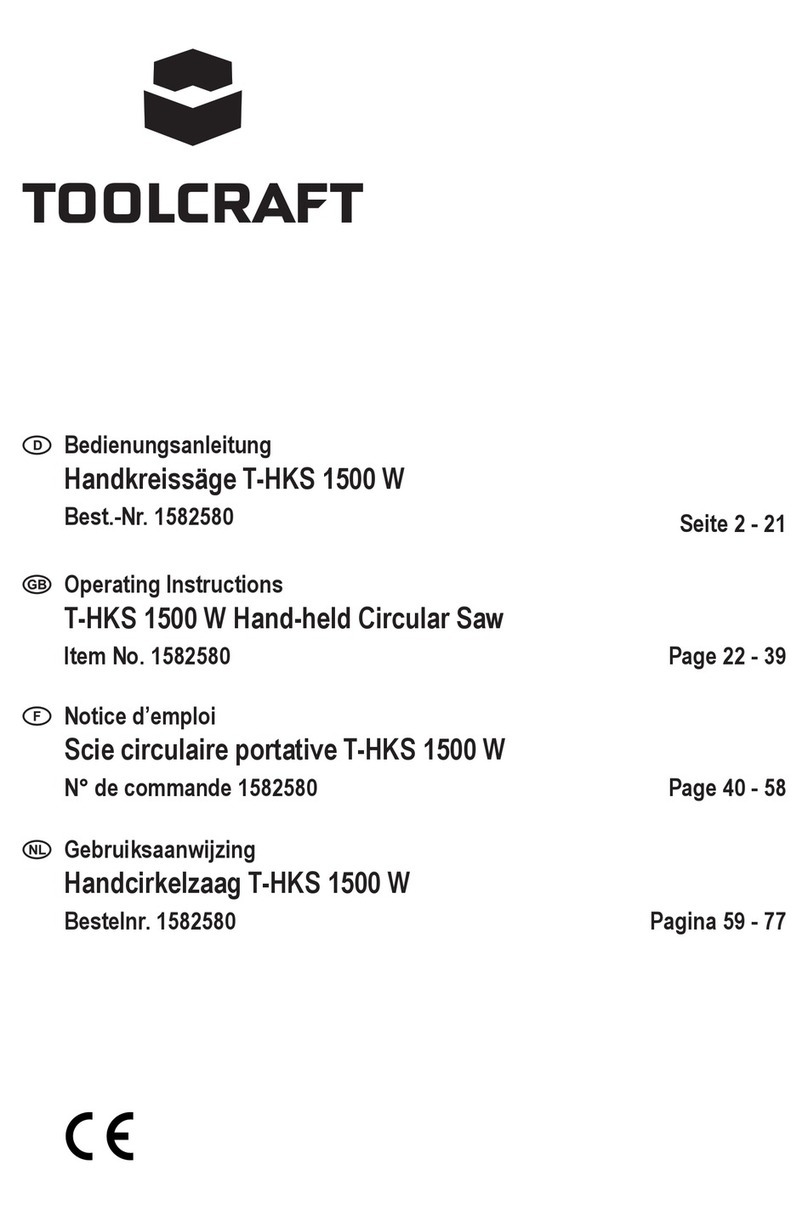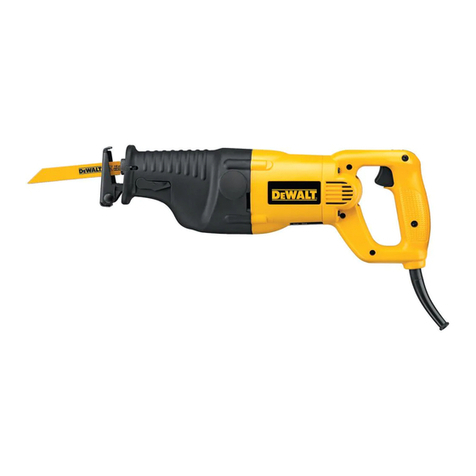FastCraft 76334-1 User manual

Model 76334-1
Circular Saw


General Power Tool Safety Warnings
: Read all safety warnings and instructions. Failure to follow
the warnings and instructions may result in electric shock, fire and/or serious
injury.
Save all warnings and instructions for future reference.
The term ″ power tool ″ in the warnings refers to your mains-operated (corded)
power tools or battery-operated (cordless) power tools.
1.Work Area Safety
a.Keep work area clean and well lit. Cluttered or dark areas invite accidents.
b.Do not operate power tools in explosive atmospheres, such as in the pres-
ence of flammable liquids, gases or dust. Power tools create sparks which may
ignite the dust or fumes.
c.Keep children and bystanders away while operating a power tool. Distrac-
tions can cause you to lose control.
2.Electrical Safety
a.Power tool plugs must match the outlet. Never modify the plug in any way.
Do not use any adapter plugs with grounded power tools. Unmodified plugs and
match- ing outlets will reduce risk of electric shock.
b.Avoid body contact with grounded surfaces such as pipes, radia- tors,
ranges and refrigerators. There is an increased risk of electric shock if your
body is grounded.
c.Do not expose power tools to rain or wet conditions. Water entering a
power tool will increase the risk of electric shock.
d.Do not abuse the cord. Never use the cord for carrying, pulling or unplug-
ging the power tool. Keep cord away from heat, oil, sharp edges or moving
parts. Damaged or entangled cords increase the risk of electric shock.
e.When operating a power tool outdoors, use an extension cord suit- able
for outdoor use. Use of a cord suitable for outdoor use reduces the risk of elec-
tric shock.
f.If operating a power tool in a damp location is unavoidable, use a residual
current device (RCD) protected supply.Use of a RCD reduces the risk of elec
tric shock.
.01.

:The term residual current device (RCD) may be replaced by the
term ground fault circuit interrupter (GFCI) or earth leakage circuit breaker (ELCB)
3.Personal Safety
a.Stay alert, watch what you are doing and use common sense when operating a
power tool. Do not use a power tool while you are tired or under the influence of
drugs, alcohol or medication. A moment of inattention while operating power tools
may result in serious personal injury.
b.Use personal protective equipment. Always wear eye protection. Protective
equipment such as dust mask, non-skid safety shoes, hard hat, or hearing protec-
tion used for appropriate conditions will reduce personal injuries.
c.Prevent unintentional starting. Ensure the switch is in the off-position before
connecting to power source and/or battery pack, picking up or carrying the tool.
Carrying power tools with your finger on the switch or energising power tools that
have the switch on invites accidents.
d.Remove any adjusting key or wrench before turning the power tool on. A wrench
or a key left attached to a rotating part of the power tool may result in personal
injury.
e.Do not overreach. Keep proper footing and balance at all times. This enables
better control of the power tool in unexpected situations.
f.Dress properly. Do not wear loose clothing or jewellery. Keep your hair, clothing
and gloves away from moving parts. Loose clothes, jewellery or long hair can be
caught in moving parts.
g.If devices are provided for the connection of dust extraction and collection facili-
ties, ensure these are connected and properly used. Use of dust collection can
reduce dust-related hazards.
4.Power Tool Use and Care
a.Do not force the power tool. Use the correct power tool for your application. The
correct power tool will do the job better and safer at the rate for which it was de-
signed.
b.Do not use the power tool if the switch does not turn it on and off. Any power
tool that cannot be controlled with the switch is dangerous and must be repaired.
c.Disconnect the plug from the power source and/or the battery pack from the
power tool before making any adjustments, changing accessories, or storing
power tools. Such preventive safety measures reduce the risk of starting the
.02.

power tool accidentally.
d.Store idle power tools out of the reach of children and do not allow persons unfa-
miliar with the power tool or these instructions to operate the power tool. Power
tools are dangerous in the hands of untrained users.
e.Maintain power tools. Check for misalignment or binding of moving parts, break-
age of parts and any other condition that may affect the power tools operation. If
damaged, have the power tool repaired before use. Many accidents are caused by
poorly maintained power tools.
f.Keep cutting tools sharp and clean. Properly maintained cutting tools with sharp
cutting edges are less likely to bind and are easier to control.
g.Use the power tool, accessories and tool bits etc. in accordance with these
instructions, taking into account the working conditions and the work to be
performed. Use of the power tool for operations different from those intended could
result in a hazardous situation.
Service
Have your power tool serviced by a qualified repair person using only identical
replacement parts. This will ensure that the safety of the power tool is maintained.
5. ADDITIONAL SAFETY RULES FOR CIRCULAR SAW
: Be sure to read and understand all instructions in this manual.
Failure to follow all instructions may result in electric shock, fire and/or serious
personal injury.
DANGER:
1) Keep hands away from cutting area and the blade. Keep your second hand on
auxiliary handle, or motor housing. If both hands are holding the saw, they cannot
be cut by the blade.
2) Do not reach underneath the workpiece. The guard cannot protect you from the
blade below the workpiece.
3) Adjust the cutting depth to the thicknessof the workpiece. Less than a full tooth
of the blade teeth should be visible below the workpiece.
4) Never hold piece being cut in your hands or across your leg. Secure the work-
piece to a stable platform. It is important to support the work properly to minimize
body exposure, lade binding, or loss of control.
5) Hold power tool by insulated gripping surfaces when performing an operation
.03.

where the cutting tool may contact hidden wiring or its own cord. Contact with a
"live" wire will also make exposed metal parts of the power tool "live" and shock
the operator.
6) When ripping always use a rip fence or straight edge guide. This improves the
accuracy of cut and reduces the chance of blade binding.
7) Always use blades with correct size and shape (diamond versus round) of
arbour holes. Blades that do not match the mounting hardware of the saw will run
eccentrically, causing loss of control.
8) Never use damaged or incorrect blade washers or bolt. The blade washers and
bolt ere specially designed for your saw, for optimum performance and safety of
operation.
Further safety instructions for all saws causes and operator prevention of
kickback:
1) Kickback is a sudden reaction to a pinched, bound or misaligned saw blade,
causing an uncontrolled saw to lift up and out of the workpiece toward the opera-
tor;
2) When the blade is pinched or bound tightly by the kerf closing down, the blade
stalls and the motor reaction drives the unit rapidly back toward the operator;
3) If the blade becomes twisted or misaligned in the cut, the teeth at the back
edge ofthe blade can dig into the top surface of the wood causing the blade to
climb out of the kerf and jump back toward the operator.
Kickback is the result of saw misuse and/or incorrect operating procedures
or conditions and can be avoided by taking proper precautions as given
below.
1)Maintain a firm grip with both hands on the saw and position your arms to
resist kickback forces. Position your body to either side of the blade, but not in line
with the blade. Kickback could cause the saw to jump backwards,but kickback
forces can be controlled by the operator, if proper precautions are taken.
2)When blade is binding, or when interrupting a cut for any reason, release the
trigger and hold the saw motionless in the material until the blade comes to a
.04.

complete stop. Never attempt to remove the saw from the work or pull the saw
backward while the blade is in motion or kickback may occur. Investigate and take
corrective actions to eliminate the cause of blade binding.
3)When restarting a saw in the workpiece, centre the saw blade in the kerf and
check that saw teeth are not engaged into the material. If saw blade is binding, it
may walk up or kickback from the workpiece as the saw is restarted.
4)Support large panels to minimise the risk of blade pinching and kickback.
Large panels tend to sag under their own weight. Supports must be placed under
the panel on both sides, near the line of cut and near the edge of the panel.
5)Do not use dull or damaged blades. Unsharpened or improperly set blades
produce narrow kerf causing excessive friction, blade binding and kickback.
6)Blade depth and bevel adjusting locking levers must be tight and secure
before making cut. If blade adjustment shifts while cutting, it may cause binding
and kickback.
7)Use extra caution when making a "plunge cut" into existing walls or other blind
areas. The protruding blade may cut objects that can cause kickback.
Safety instructions for saws with a pendulum blade guard
1)Check lower guard for proper closing before each use. Do not operate the saw
if lower guard does not move freely and close instantly. Never clamp or tie the
lower guard into the open position. If saw is accidentally dropped, lower guard
may be bent. Raise the lower guard with the retracting handle and make sure it
moves freely and does not touch the blade or any other part, in all angles and
depths of cut.
2)Check the operation of the lower guard spring. If the guard and the spring are
not operating properly, they must be serviced before use.
3)Lower guard may operate sluggishly due to damaged parts, gummy deposits,
or a build-up of debris. Lower guard should be retracted manually only for special
cuts such as" plunge cuts “and "compound cuts". Raise lower guard by retracting
handle and as soon as blade enters the material, the lower guard must be
released. For all other sawing, the lower guard should operate automatically.
4)Always observe that the lower guard is covering the blade before placing saw
down on bench or floor. An unprotected, coasting blade will cause the saw to walk
backwards, cutting whatever is in its path. Be aware of the time it takes for the
.05.

blade to stop after switch is released.
Additional safety instructions for all saws with riving knife
1)Use the appropriate riving knife for the blade being used.For the riving knife to
work, it must be thicker than the body of the blade but thinner than the tooth set of
the blade.
2)Adjust the riving knife as described in this instruction manual. Incorrect
spacing, positioning and alignment can make the riving knife ineffective in pre-
venting kickback.
3)Always use the riving knife except when plunge cutting. Riving knife must be
replaced after plunge cutting.Riving knife causes interference during plunge cut-
ting and can create kickback.
4)For the riving knife to work, it must be engaged in the workpiece. The riving
knife is ineffective in preventing kickback during short cuts.
5)Do not operate the saw if riving knife is bent. Even a light interference can
slow the closing rate of a guard.
Additional safety instructions for circular saws
1)Wear ear protectors. Exposure to noise can cause hearing loss.
2)Preferably wear a dust mask.
3)Do not use blades of larger or smaller diameter than recommended. For the
proper blade rating refer to the technical data. Use only the blades specified in
this manual, complying with GB.
4)Do not use distorted or cracked saw blades.
5)Do not use a blade made of high-speed steel.
6)Do not use a blade not in conformity with features as described in this manual.
7)Do not exert lateral force to stop the blade.
8)Do not set the movable guard in the open position.
9)Ensure freely moving guard without binding.
10)Ensure proper movement of retracting mechanism of all the protection
system.
.06.

SYMBOL DESCRIPTION
Class II construction Double Insulated construction
Read the manual before set-up and/or use.
Wear safety glasses, ear protection and respiratory protection.
11)Prior to blade replacement, adjustment or other maintenance, always unplug
the tool.
12)Never use any abrasive wheel unless a tool is specially designed for abrasive
wheels.
13)Do not use a blade with thinner blade body than the riving knife and tooth set.
14)The riving knife must be adjusted not more than 5 mm from the blade tooth
circle, and the tooth length below the lower edge of the riving knife shall not be
bigger than 5 mm.
15)Always use the riving knife except when plunge cutting.
16)Never use abrasive cut-off wheels.
WARNING: Some dust created by power Cutting contains chemicals known to
cause cancer, birth defects or other reproductive harm. Some examples of these
chemicals are:
1) lead from lead-based paints
2)Arsenics and chromium from chemically reacted lumber.
Your risk from these exposures varies, depending on how often you do this type of
work. To reduce your exposure to these
chemicals: work in a well ventilated area, and work with approved safety equip-
ment.
6.SYMBOLS
a.Some of the following symbols may appear on this product. Study these
symbols and learn their meanings. Proper interpretation of these sym- bols
will allow for more efficient and safer operation of this product.
.07.

Use dust mask. Dust which is injurious to health can be
generated when working on wood and other materials.
Never use the device to work on any materials
containing asbestos.
Do not dispose with house-hold waste.
Voltage & Frequency:
Input Power:
No Load Speed:
Blade Size:
Max. cutting depth:
120V~ 60Hz
13A
5800 min-1
7-1/4"
2-1/2" @90degree
1-7/8" @45degree
1.Front handle
2.Spindle lock
3.Bevel adiustment knob
4.Lower guard
5.Saw blade
6.Base plate
7.Lower guard retracting lever
8.On/off switch
9.Safety button
10.Depth adjustment knob
11.Ripfence lock knob
12.Parallel fence
13.Cutting mark 45°
b.TECHNICAL SPECIFICATIONS
c.FUNCTION DESCRIPTION
10
11
.08.
DESCRIPTION OF THE TOOL
PERATING CONTROL
The power tool is intended for cu�ng wood lengthways and crossways in straight
lines and at bevel angles of up to 45° on a firm surface.
1. MAIN PARTS
1.Front handle
2.Spindle lock
3.Bevel adjustment knob
4.Lower guard
5.Saw blade
6.Base plate
7.Lower guard retrac�ng lever
8.On/offswitch
9.Safety bu�on
10.Depth adjustment knob
11.Ripfence lock knob
12.Parallel fence
13.Cu�ng mark 450
14.Cu�ng mark 00
12
1
3
13
14
4
5
6
7
8
9
2

7.OPERATION
Prior to assembly and adjustment always
unplug the tool.
1、Depth of cut adjustment
1)Loosen the depth adjustment knob
(11).
2)Move the base plate (6) to obtain the
correct depth of cut.
3)Tighten the depth adjustment knob (11).For optimal results, allow the saw blade
to protrude from the workpiece by about 3 mm.
2、Bevel adjustment
The bevel angle can be adjusted between 0°and 45°.
1)Loosen the bevel adjustment knob (3).
2)Set the bevel angle by tilting the base plate(6) until the mark indicates the
desired angle on the scale.
3)Tighten the bevel adjustment knob (3).
3、Shoe adjustment for 90°cuts
1)Adjust the saw to 0o bevel.
2)Retract the blade guard using the lever (7) and place the saw on the blade side.
3)Loosen the bevel adjustment knob (3).
4)Place a square against the blade and shoe to adjust the 90°setting.
3、Replacing the saw blade
Be careful to turn off the switch and
unplug the power plug before installing or
disassembling the wheel disc.
To disassemble the blade ( 5 ), press the
shaft lock rod forcefully first so that the
blade cannot rotate.using the spanner
(18)Counterclockwise loosening of
hexagonal bolts (14), Remove hexagonal
bolts (17), washers (16&15)and blade
(5).
.09.
2
15
5
16
17
18

Install the blade ( 5 ) according to the reverse procedure of dismantling the wheel
blade. When installing the blade, make sure that the direction indicated by the
arrow on the blade surface is the same as the direction indicated by the arrow on
the wheel cover. The hexagonal bolt (17) must be tightened firmly
4、Mounting and adjusting the parallel fence
The parallel fence (12) is used for cutting parallel to the edge of the workpiece.
Mounting
1)Slacken the locking screw (3) as to allow the parallel fence to pass.
2)Insert the parallel fence (12) in the base plate(6) as shown.
3)Tighten the locking screw (3).
Adjusting
1)Slacken the locking screw (3) and set the parallel fence (12) to the desired
width.
2)Tighten the locking screw (3).
8.Maintenance
Never use aggressive detergents or solvents for cleaning.
a.To prevent accidents, always unplug the saw from the power source before
cleaning or performing any maintenance the saw may be cleaned most effectively
using compressed air.Always wear safety goggles when using compressed air. If
compressed air is not available, use a brush to remove dust and chips from the saw.
b.Motor ventilation vents and switch levers must be kept clean and free of foreign
matter. Do not attempt to clean by inserting pointed objects through open- ings.
c.Never use any caustic agents to clean plastic parts. Such as: gasoline, carbon
tetrachloride, chlorinated cleaning solvents, ammonia and household cleaners
containing ammonia. Do not use any of these to clean the saw.
d.Have an authorized service center examine and/or replace the worn carbon
brushes in the event of excessive parking.
e.Blades become dull even when cutting regular lumber, a sure sign of a dull blade
is the need to force the saw forward instead of guiding it while making a cut. Take
the blade to a service center for sharpening.
.10.

f.Keep the machine clean all the time.
g.If you discover any damage, consult the exploded drawing and parts list to de-
termine exactly which replacement part you need to order from our customer ser-
vice department.
h.Clean the housing only with a damp cloth. Do not use any solvents! Dry thor-
oughly afterwards.
i.If the supply cord of this power tool is damaged, it must be replaced by a similar
cord available through the service organization or a qualified authoritative techni-
cian.
: Do not use cleaning agents to clean the plastic parts of the
tool. A mild detergent on a damp cloth is recommended. Water must never
come into contact with the tool.
9.Transport
Turn the motor off and disconnect the mains plug. While transporting, be careful
not to drop, or shock the machine. For transport, the machine has to be fixed
against slipping and tipping over. Do not place objects on the machine.
10.Meaning of crossed –out wheeled dustbin:
Do not dispose of electrical appliances as unsorted municipal waste, use separate
collection facilities. Contact your local government for information regarding the
collection systems available. If electrical appliances are disposed of in landfills or
dumps, hazardous substances can leak into the groundwater and get into the food
chain,damaging your health and well-being
11.After sales
For questions about this or any other FastCraft Products, please email us:
FastCraft @nyclcompany.com.
.11.



Table of contents


